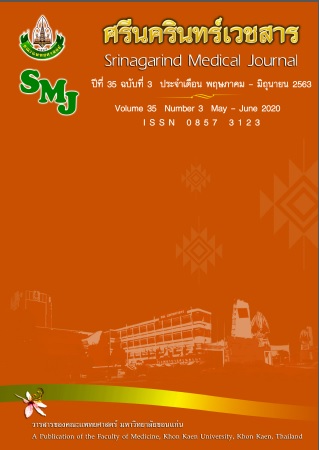Risk Factors for Birth Asphyxia in Newborns Delivered at Nongkhai Hospital
Keywords:
Birth asphyxia; Risk factorAbstract
Background and Objectives: Birth asphyxia is an important cause of perinatal death. The causes of birth asphyxia are mostly could be prevented or corrected in advance. This retrospective case-control study was undertaken to identify risk factors for birth asphyxia in Nongkhai hospital.
Methods: The medical records and birth registration database of 873 women giving birth at Nongkhai hospital during January 2018 to June 2019 were reviewed.. The study group comprised of 129 women who delivered newborns with an APGAR score at 1 minute equal to 7 or less, while the control group comprised of 258 women who delivered newborns with an APGAR score at 1 minute more than 7. The potential factors affecting the risk of birth asphyxia were determined using the t-test and Chi-square. Multiple logistic regression was used to analyze the variables that were independently associated with birth asphyxia.
Results: Significant risk factors for birth asphyxia included fetal distress (OR=27.20, 95%CI=5.75-128.82), placenta previa (OR=13.49 , 95%CI=1.28-142.13), premature rupture of the membranes (OR=5.83, 95%CI=1.56-21.80), pregnancy induce hypertension (OR=4.49, 95%CI=1.55-12.98), and birth weight lower than 2,500 grams (OR=1.94, 95%CI=1.07-6.26), respectively.
Conclusion: Risk factors of birth asphyxia could be prevented. The early diagnosis and proper management will decrease birth asphyxia during delivery.
References
2. Tagin MA, Woolcott CG, Vincer MJ, Whyte RK, Stinson DA. Hypothermia for neonatal hypoxic
ischemic encephalopathy: an updated systematic review and meta-analysis. Arch Pediatr
Adolesc Med 2012; 166: 558-66.
3. Mohd Ashraf, Ahmed N, Chowdhary J, Saif RU. Acute renalfailure: nephrosonographic findings
in asphyxiated neonates. Saudi J Kidney Dis Transpl 2011; 22: 1187-92.
4. Alaro D, Bashir A, Musoke R, Wanaian L. Prevalence and outcomes of acute kidney injury in
term neonates with perinatal asphyxia. Afr Health Sci 2014; 14: 682-8.
5. Thibeault DW1, Hall FK, Sheehan MB, Hall RT. Postasphyxial lung disease in newborn infants with severe perinatal acidosis. Am J Obstet Gynecol 1984; 150: 393-9.
6. Berseth CL, McCoy HH. Birth asphyxia alters neonatal intestinal motility in term neonates.
Pediatrics 1992; 90: 669-73.
7. สุนทร ฮ้อเผ่าพันธุ์. Defining the scope of perinatal asphyxia. ใน: สุนทร ฮ้อเผ่าพันธุ์,
บรรณาธิการ. Neonatology. พิมพ์ครั้งที่ 1.กรุงเทพฯ: ธนาเพรสจำกัด, 2550: 76-97.
8. กำแหง จาตุรจินดา, ประทักษ์ โอประเสริฐสวัสดิ์. การตายของทารกแรกปริกำเนิด ใน: กำแหง จา
ตุรจินดา, บรรณาธิการ. สูติศาสตร์รามาธิบดี. พิมพ์ครั้งที่ 1.กรุงเทพฯ: เมดิคอลมีเดีย, 2530: 59-74.
9. ธราธิป โคละทัต. การเสียชีวิตของทารกแรกเกิด กุมารเวชศาสตร์. เล่ม 1 พิมพ์ครั้งที่ 2. กรุงเทพฯ:
เรือนแก้วการพิมพ์; 2543: 203-11.
10. The international classification of disease 10 revision Thai Mod Vol. 2. Ministry of public
health Bureau of policy and strategy office of the permanent secretary, 2nd edition 2006: 265.
11. ตัวชี้วัดและเป้าหมายงานอนามัยแม่และเด็กประจำปี 2562. สำนักส่งเสริมสุขภาพกรมอนามัย
กระทรวงสาธารณสุข. 2562.
12. อร่าม ลิ้มตระกูล. ปัจจัยสาเหตุและแนวทางการป้องกันภาวะขาดออกซิเจนในทารกแรกเกิด
โรงพยาบาลนครพิงค์ จังหวัดเชียงใหม่ 2548-2550. วารสารวิชาการสาธารณสุข 2551; 17: 303-10.
13. เปรมฤดี อริยานนท์. ปัจจัยเสี่ยงสำหรับการเกิดภาวะ การขาดออกซิเจนของทารกปริกำเนิดใน
โรงพยาบาลนครปฐม วารสารแพทย์เขต 4-5. 2555; 31: 260-8.
14. สมบัติ ศักดิ์สง่าวงษ์ และสุธีร์ รัตนะมงคลกุล. ปัจจัยเสี่ยงและคะแนนความเสี่ยงของการเกิดภาวะ
ขาดออกซิเจนในทารกแรกเกิดในโรงพยาบาลกุมภวาปี จ.อุดรธานี. เวชสารแพทย์ทหารบก 2561;
72: 41-52.
15. พิชิต เผื่อนงูเหลือม. ปัจจัยที่ส่งผลต่อภาวะขาดออกซิเจนของทารกแรกเกิดในครรภ์ครบกำหนดที่
โรงพยาบาลมหาราชนครราชสีมา. วารสารการแพทย์โรงพยาบาลศรีสะเกษ สุรินทร์ บุรีรัมย์ 2553;
25: 265-78
16. นงเยาว์ สุวรรณกันทา. ปัจจัยที่มีความสัมพันธ์กับภาวะขาดออกซิเจนของทารกปริกำเนิดใน
โรงพยาบาลนครพิงค์ จังหวัดเชียงใหม่. วารสารสาธารณสุขล้านนา 2557; 10: 229-36.
17. ชาญ พานิชวัฒนะ, สุจินต์ ธรรมดี, เต็มดวง เข้มแข็ง. ปัจจัยที่ส่งผลต่อภาวะขาดออกซิเจนของ
ทารกแรกคลอดในโรงพยาบาลอุตรดิตถ์. วารสารวิชาการแพทย์เขต 8 2543; 8: 53-66.
18. Milsom I, Ladfors L, Thiringer K, Niklasson A, Odeback A, Thomberg E. Influence of maternal obstetric and fetal risk factors on the prevalence of birth asphyxia at term in a Swedish urban population. Acta Obstet Gynecol Scand 2002; 81: 909-17.
19. อรรถพล เกิดอรุณศรี. ความชุกและปัจจัยที่สัมพันธ์กับการเกิดภาวการณ์ขาดออกซิเจนในทารก
แรกเกิดในโรงพยาบาลราชพิพัฒน์. วชิระเวชสาร 2547; 48: 79-86.
20. Lee AC, Mullany LC, Tielsch JM, Katz J, Khatry SK, LeClerq SC, et al.
Risk factors for neonatality due to birth asphyxia in southern Napal: a prospective, community-based cohort study. Pediatrics 2008; 121: e1381-90.doi:10. 1542/peds. 2007-1996.
21. Chen ZL1, He RZ, Peng Q, Guo KY. Zhang YQ, Yuan HH, Liu JX. Prenatal risk for neonatal asphyxia: how risk for each ?. Zhongguo Dang Dai Er Ke Za Zhi 2009;11: 161-5.
22. ชญาศักดิ์ พิศวง, ปริศนา พานิชกุล. ปัจจัยเสี่ยงที่สัมพันธ์กับภาวะขาดออกซิเจนของทารกแรกเกิด
ในโรงพยาบาลพระมงกุฎเกล้า. เวชสารแพทย์ทหารบก 2554; 64: 109-19.
23. อุไร ศิลปะกิจโกศล. ปัจจัยเสี่ยงการขาดออกซิเจนในทารกแรกคลอด โรงพยาบาลพนมสารคราม
ฉะเชิงเทรา. วารสารวิจัยระบบสาธารณสุข 2551; 2: 1315-24.
24. บรรพจน์ สุวรรณชาติ. ปัจจัยเสี่ยงของการเกิดภาวะขาดออกซิเจนในทารกแรกเกิดในโรงพยาบาล
กาฬสินธุ์. ศรีนครินทร์เวชสาร 2547; 19: 233-40.
25. มนตรี ภูริปัญญวานิช. ปัจจัยเสี่ยงต่อการเกิดภาวะขาดออกซิเจนในทารกแรกเกิดของโรงพยาบาล
เสนา. วารสารวิจัยวิทยาศาสตร์การแพทย์ 2551; 22: 83-9.




